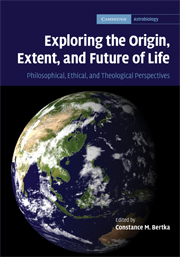 Exploring the Origin, Extent, and Future of Life
Exploring the Origin, Extent, and Future of Life Book contents
- Frontmatter
- Contents
- List of contributors
- Acknowledgements
- 1 Astrobiology in a societal context
- Part I Origin of life
- 2 Emergence and the experimental pursuit of the origin of life
- 3 From Aristotle to Darwin, to Freeman Dyson: changing definitions of life viewed in a historical context
- 4 Philosophical aspects of the origin-of-life problem: the emergence of life and the nature of science
- 5 The origin of terrestrial life: a Christian perspective
- 6 The alpha and the omega: reflections on the origin and future of life from the perspective of Christian theology and ethics
- Part II Extent of life
- Part III Future of life
- Index
- References
5 - The origin of terrestrial life: a Christian perspective
from Part I - Origin of life
Published online by Cambridge University Press: 29 December 2010
- Frontmatter
- Contents
- List of contributors
- Acknowledgements
- 1 Astrobiology in a societal context
- Part I Origin of life
- 2 Emergence and the experimental pursuit of the origin of life
- 3 From Aristotle to Darwin, to Freeman Dyson: changing definitions of life viewed in a historical context
- 4 Philosophical aspects of the origin-of-life problem: the emergence of life and the nature of science
- 5 The origin of terrestrial life: a Christian perspective
- 6 The alpha and the omega: reflections on the origin and future of life from the perspective of Christian theology and ethics
- Part II Extent of life
- Part III Future of life
- Index
- References
Summary
When the “origin-of-life” issue is debated nowadays, the question most often asked is: How did the first cell originate? What sequence of processes could have given rise to the extraordinary complexity of even the most rudimentary living cell? Once such a cell was in place, the assumption is that metabolism and descent with modification could begin and the Darwinian selection process could get under way, generating over the course of aeons the vast profusion of natural kinds, living and extinct, that we know. But what sort of selection principles, working on what sort of materials, could have sufficed in the first place to build up the kind of intricate structure that even the smallest functioning cell requires? In short, how did the living come from the non-living in the first place?
In earlier centuries, the transition from non-life to life would have seemed unproblematic, indeed entirely commonplace. It would have appeared obvious that living comes from non-living in the world of nature all the time: maggots develop in decaying flesh, tiny worms appear in rotting fruit, and so on. At the lowest levels of living complexity, matter (it seemed) could generate life unaided. Only with the advent of the microscope and finally the experiments of Pasteur was it shown that this kind of spontaneous generation was only apparent: no real transition from non-living to living actually occurred in it. So how did life begin?
- Type
- Chapter
- Information
- Exploring the Origin, Extent, and Future of LifePhilosophical, Ethical and Theological Perspectives, pp. 80 - 95Publisher: Cambridge University PressPrint publication year: 2009
References
- 3
- Cited by
